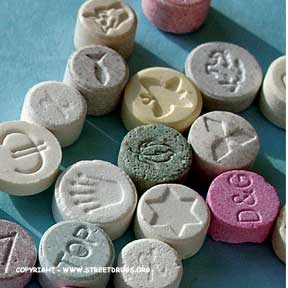
MDMA abuse and the trafficking of MDMA is on the rise, posing serious social concerns.
Once confined to major metropolitan areas, MDMA trafficking has now expanded to
smaller communities. Teenagers and young adults continue to be the primary targets
of sophisticated crime syndicates who are supplying distribution groups with ever-increasing
amounts of MDMA tablets. As the trend to consume MDMA in tandem with alcohol and
other drugs continues, the harmful effects of the drug will increase exponentially.
MDMA (3,4-methylenedioxy-N-methylamphetamine), also referred to as Ecstasy, XTC,
Adam, and Essence, is a illegally manufactured variation of mescaline and amphetamine.
It is considered a designer drug - a substance on the drug market that is a chemical
analogue or variation of another psychoactive drug.
MDMA is marketed as a feel good drug. Devotees say it produces profoundly positive
feelings, empathy for others, elimination of anxiety, and extreme relaxation,hence
the nickname "hug drug," or "love drug." MDMA is also said to suppress the need
to eat, drink, or sleep, enabling club scene users to endure all-night and sometimes
two, or three-day parties.
MDMA is taken orally, usually in tablet or capsule form. MDMA tablets are often
"stamped" with icons or logos intended to appeal to a young audience. Its effects
last approximately four to six hours.
Tablets sold as Ecstasy are not always pure MDMA. As demand for Ecstasy has increased,
so has the appearance of Ecstasy "fakes" often containing other substances such
as amphetamine, caffeine, codeine, DXM, ephedra/ephedrine, ketamine, MDA, methamphetamine,
and PCP. When used alone, MDMA is dangerous. It is even more dangerous when used
in combination with other substances, as the physical and psychological effects
are difficult to determine or predict.